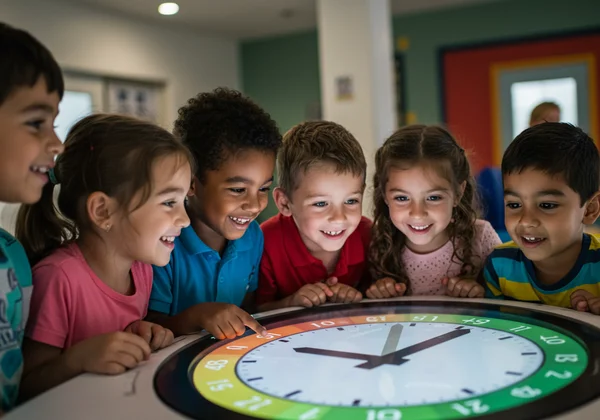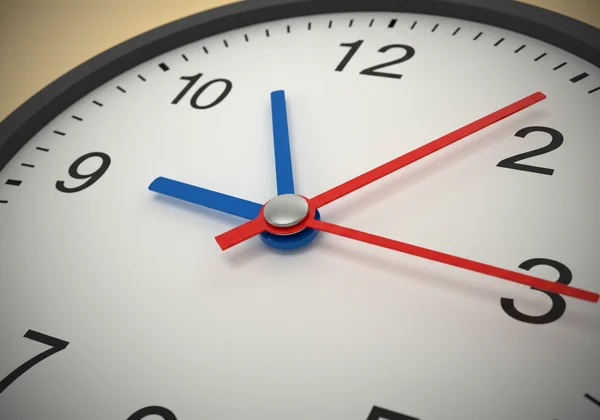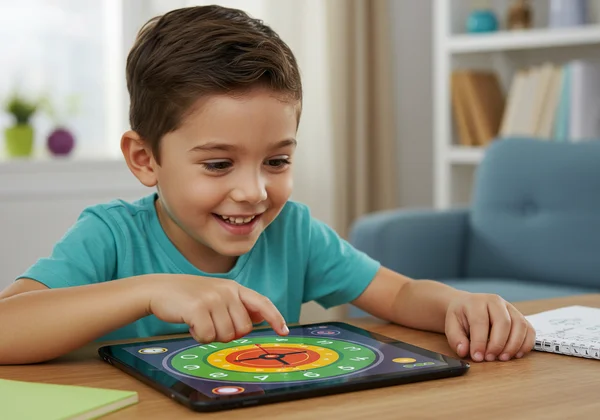Mastering Minutes: Telling Time on an Analog Clock
Learning to tell time is a major milestone for any child. They might quickly grasp the concept of the hour hand, easily identifying 2 o'clock or 5 o'clock. But when the long minute hand enters the picture, moving between the big numbers, things can get tricky. Moving beyond hours and half-hours to the precision of minutes can challenge kids and even the parents and teachers guiding them. This guide will make telling time on an analog clock, especially mastering minutes, a fun and easy adventure.
Many parents and educators wonder: But how do you transform that confusion into confidence? The secret lies in breaking it down into simple steps and making practice a playful experience. This article will provide a clear, step-by-step method to teach any child to read the exact minute. With the right approach and tools, like a free interactive teaching clock, you can set your child up for complete time-telling fluency.

Understanding Minutes: The Foundation of Telling Time
Before a child can read the time as "10:48," they need to understand what a minute is and why it's so important. The hour gives us a general idea, but the minutes give us precision. They are the building blocks that connect one hour to the next, helping us understand schedules, plan activities, and make sense of our day.
Why Every Tick of the Clock Matters
Each of the 60 minutes in an hour has a purpose. They tell us when it's time to leave for school, when a favorite show starts, or how long until dinner is ready. Explaining this context helps a child see the value in learning beyond the hour. It's not just about reading numbers on a clock; it’s about understanding the rhythm of their own day. This makes the learning process much more meaningful and motivating for a young learner.
The Hour Hand vs. The Minute Hand: A Quick Refresher
A quick review of the basics is always a great starting point. On our educational clock for kids, we make this easy with distinct colors.
- The Blue Hour Hand: This is the short, slower hand. It points to the big numbers on the clock to tell us the hour.
- The Red Minute Hand: This is the long, faster hand. It moves all the way around the clock once every hour, pointing to the minutes.
Clarifying these roles is the first step. Once a child is confident about which hand does what, they are ready to tackle the minutes.

Reading the Clock: Mastering 5-Minute Intervals with Ease
The first major leap in mastering minutes is learning to count in blocks of five. This simplifies the clock face and turns a daunting task into a simple counting exercise. It’s a core skill for anyone learning reading the clock efficiently.
Counting by Fives: The Secret Code of Analog Clocks
Let’s reveal the secret code of the analog clock! Explain to your child that each big number on the clock face also represents a group of five minutes for the long minute hand. The number 1 is 5 minutes, the 2 is 10 minutes, the 3 is 15 minutes, and so on.
You can practice this by "skip counting" around the clock: 5, 10, 15, 20, 25, 30, 35, 40, 45, 50, 55, 60. This rhythmic counting is easy for kids to remember and apply. When the minute hand points directly at a number, they can use this secret code to instantly know the minutes.
Fun Practice: Using an Interactive Clock for 5-Minute Drills
This is where hands-on practice makes all the difference. Reading about it is one thing, but doing it solidifies the knowledge. Using an interactive clock, a child can physically move the minute hand and see the digital time change instantly.
Challenge your child with fun drills. Say, "Can you set the clock to 4:25?" They will need to drag the blue hour hand to the 4 and the red minute hand to the 5. These interactive telling time games provide immediate feedback, building confidence with every correct answer.

Pinpointing Exact Time: Counting Individual Minutes
Once a child is a pro at counting by fives, they are ready for the final step: pinpointing exact time. This involves reading the small tick marks between the big numbers, which can seem intimidating at first. But with a clear method, it becomes a simple two-step process.
Beyond the Big Marks: Understanding One-Minute Increments
Show your child the small lines between the numbers on the clock. Explain that each of these little ticks stands for one single minute. There are four of these small ticks between each big number. Counting them up, along with the big number marks, gives us a total of 60 minutes in one full circle. This visual helps them understand the structure of a full hour.
Step-by-Step: How to Read Any Minute on the Clock
Here is a simple, foolproof method to read the exact minute every time:
- Start with Fives: Look at the last big number the long minute hand has passed. Use your skip-counting skill to find its value in minutes.
- Add the Ones: From that big number, count the small tick marks one by one until you reach the minute hand.
- Put It Together: Add the number from step 2 to the number from step 1. That's your exact minute!
For example, if the hour hand is past the 10 and the minute hand is two ticks past the 8:
- Step 1: The minute hand is past the 8. We count by fives to get to 40.
- Step 2: We count two small ticks after the 8. That's 2 minutes.
- Step 3: We add them: 40 + 2 = 42. The time is 10:42!
Real-World Scenarios: Applying Your New Skills
Connect this new skill to everyday life to make it stick. Look at a real analog clock in your home and ask, "What time is it right now?" Use specific times when planning activities. "We will start our movie night at 7:12," or "You have until 3:38 to finish your game." This makes reading the exact time a practical and useful skill, not just a classroom exercise.
Tips for Teaching & Learning Time to the Nearest Minute
Every child learns at their own pace. For parents and teachers using a teaching clock, the key is to be patient, encouraging, and creative. Turning lessons into playtime is the most effective strategy for keeping kids engaged and eager to learn.
Make it a Game: Creative Activities for Minute Mastery
Transform practice sessions into fun timetelling games. With our online tool, you can:
- Use the "Random Time" Button: Click this to generate a surprise time. The first person to read it correctly wins a point!
- Play "Hide and Seek": Use the "Hide Digital Time" feature. Set a time on the clock, and have your child guess. Then, click "Show Digital Time" for the big reveal.
- Give Time Challenges: Give verbal commands like "Show me 27 minutes past 6." This encourages them to use the adjustable clock hands to practice setting time, not just reading it.
Patience and Consistency: Keys to Confidence
Remember that mastering any new skill takes time. Frustration can quickly lead to disinterest. Keep practice sessions short, positive, and frequent—five to ten minutes a day is far more effective than a stressful one-hour lesson. Celebrate small victories and praise their effort, not just their accuracy. This builds a foundation of confidence that will motivate them to keep trying until it finally clicks.
Your Child's Time-Telling Journey to Precision!
From understanding the basic roles of the hands to pinpointing the exact minute, learning to tell time is a journey. By breaking it down into manageable steps—mastering fives, then adding ones—you can guide any child to success. The most important ingredient is fun, interactive practice that allows them to learn by doing.
Are you ready to stop the struggles and start the fun? Give your child the tools to succeed. Head over to our Fun Clock Playground and let them explore, play, and become a confident time-telling expert.
Frequently Asked Questions About Telling Time to the Minute
How do you read an analog clock step by step?
Start with the short hour hand to find the hour. Then, look at the long minute hand. Find the last big number it passed and count by fives to get those minutes. Finally, count the small tick marks from there to find the exact minute.
How do you explain the hour and minute hand to a child effectively?
Use simple associations. The hour hand is "short and slow" because hours are long. The minute hand is "long and fast" because it has to race around the clock every hour. Using colors, like our blue hour hand and red minute hand, also helps differentiate them.
What age should a child be able to read an analog clock accurately?
Most children begin learning between ages 5 and 7. They typically master telling time to the hour and half-hour first. Reading time to the nearest five minutes and then to the exact minute usually develops between ages 6 and 8, but every child's pace is different.
Are analog clocks better than digital for learning time?
Yes, for learning, analog clocks are superior. They provide a visual representation of time passing and concepts like "quarter past" and "half past." This helps children build a stronger conceptual understanding of time that a digital display cannot offer.
How can an online analog clock help with minute practice?
An online analog clock offers a dynamic learning experience. Tools like ours allow children to drag the hands and see the digital time update in real-time. Features like "Random Time" create fun quizzes, and the ability to hide the digital display is perfect for self-testing. It turns practice from a chore into an engaging game. Start your time games practice today.